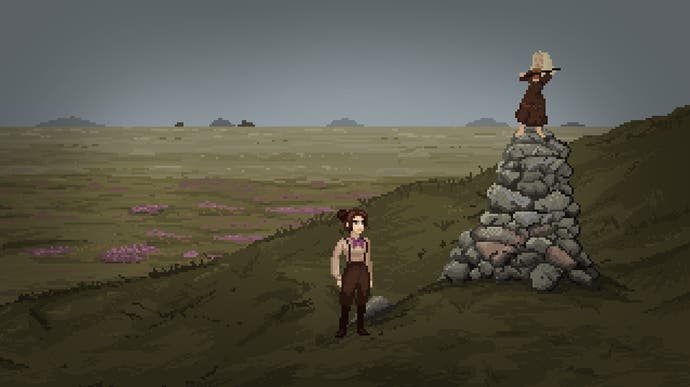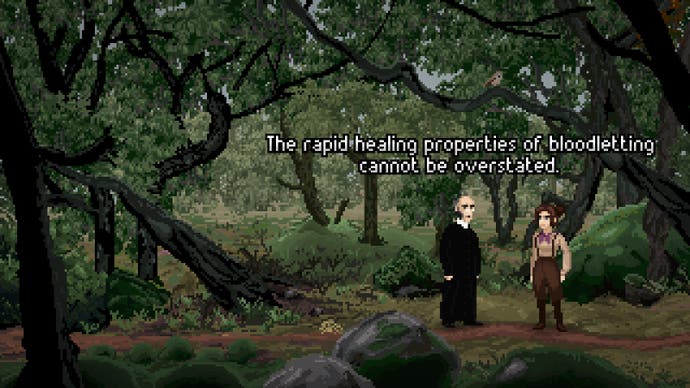The Excavation of Hob's Barrow review - an adventure game with depth
By gaslight...
SPOILER WARNING: I try not to reveal specifics of Hob's Barrow in this piece, but to get at what's special about this game, I've had to talk about certain elements of the design that you might not want to know going in.
My favourite moment in The Excavation of Hob's Barrow came about three hours after I'd finished it. But we'll get to that in a bit.
From the off, it's hard not to root for Thomasina Bateman. In an age of steam trains and parasols, she has come to a small village in the north of England to dig up an ancient burial site, regardless of all the obstacles the local patriarchy - and the soggy English weather - can place in her way.
And it's hard not to root for The Excavation of Hob's Barrow itself. Here's a compact yet carefully made point-and-click horror delivered in the classic adventure game style. The interface and inventory are pleasantly streamlined - there's a button to show all points of interest, and you can even warp to exits with a double-click - but the stately pace of a classic adventure game is adhered to with great reverence.
The less you know about the story going in, the better. Just be aware that there is a barrow that Thomasina wants to dig up, but her first tasks involve getting the local folk to admit that this barrow even exists. And she has to convince some of them to even acknowledge her for starters. How do you go about this stuff? Classic adventure game business, obviously: talking to everyone until there's nothing left to ask them, picking up anything that isn't stuck to the floor and keeping an eye on promising locked doors.
The animation is lovely, switching between elegant, beautifully animated sprites as you move around the world, and jarring, rather terrifying close-ups as you watch cut-scenes. In harmony with this, secondary characters walk a fine line between appearing human and inhabiting all the horror fiction and small town stereotypes you might desire.
The puzzles, particularly in the game's first two thirds, manage to be pleasant work which keeps you thinking but never creates annoying roadblocks. You're always working out what you want, while keeping an eye on what other people want to - so that you can create synergies where these wants overlap.

More than puzzling, though, it's just a pleasure to be in such an atmospheric world. The landscapes are by Constable and the dialogue is brisk and characterful. There are times early on, as Thomasina encounters local idiots who want to put her in her place as a woman, and other local idiots who want to engage her in discussions examining the conflict between folklore and rationality, where the whole thing threatens to become a kind of playable Essex Serpent, that other carefully Gothic story built of displacement and superstition. The railway's just come to the area - is it the end of everything holy? This is all wonderfully done.
The Essex Serpent's an interesting touchpoint. Sarah Perry's novel flirts with horror in the service of something deeper, stranger, and ultimately sweeter. At first - and 'at first' counts all the way up until the credits rolled and a few hours beyond - I was tempted to say that Hob's Barrow flirts with flirting with horror, before settling more firmly into safe genre territory. The game moved with grace, and I was gripped until the end, but there were moments where I worried that fealty to the traditions and specific narrative gravity of horror got in the way of a more interesting story that Hob's Barrow was starting to tell. Horror offers thrills and proper magic, but doesn't it often come with requirements and restrictions?
Equally, narrative choices made by the developers enforces a change in the kind of puzzles I encountered as things worked towards the climax. I moved from playful set-pieces that encouraged me to think about the people around me and how I might use social engineering to get what I want, to much more mechanical adventure game stuff. Again, it was beautifully handled, and there's a lovely sense of doomy mystery throughout, but Thomasina's such a charismatic protagonist I missed the parts of the game that saw her engaged with other people.

To quote another Thomasina: you cannot stir things apart. Or can you? After I finished the game I slumped off to do the dishes, quietly disappointed. I walked through a familiar checklist of disappointed thoughts. The danger, I reminded myself, is of getting annoyed that Hob's Barrow isn't quite the game I want it to be. Sure, I thought, I am very happy to put everything else aside and enjoy this characterful slice of dark-hearted English folklore. But even so, I suspected that, towards the end in particular, Hob's Barrow wasn't quite the game Hob's Barrow wanted to be either. It left too many interesting themes aside as it raced to the conclusion. Thomasina's such a brilliant creation she deserves a game that gives her a bit more agency.
I plucked away at threads like this for four hours that day, until everything clicked. I suddenly felt like I understood something much deeper about what the game was trying to say, and how it used horror elements rather than gave way to them. What a brilliant thing this is - a puzzle in itself, every bit as much as something like Link's Awakening - but a narrative, thematic puzzle rather than a spatial puzzle in which the map itself is a giant brainteaser.
And here's the thing: those four hours after finishing the game and turning off the computer, those four hours are where I truly played Hob's Barrow. Busywork and dialogue aside they're where I sorted the narrative, untangled the true theme and made sense of what I'd witnessed. Yet more proof, I guess, that for some games, what we call gameplay extends far beyond the screen and the keyboard or controller.
Under those Constable skies and that endless drizzle, then, Hob's Barrow works a sneaky kind of magic. Dig in.



